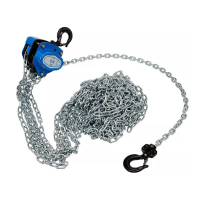What to do if Tractel Chain Hoists load has jammed?

What to do if Tractel Chain Hoists load has jammed?
Defines terms like System/Machine, System manufacturer, Rigging, Anchoring point, Supervisor, Actuation, Operating personnel, Operator, Running hours, Electrician, SAFETY-STOP, Fall arrest device, Overall suspended load.
Explains DANGER, ATTENTION, NOTE symbols and icons for material/people transport.
Provides critical safety warnings for operating the hoist, emphasizing correct usage, maintenance, and avoiding damaged parts.
Outlines operator responsibilities, training requirements, emergency rescue plans, and the importance of warning signs.
Details the manufacturer's role in design, CE marking, and ensuring product compliance with regulations and proper installation.
Confirms the hoist is delivered fully assembled, ready for installation.
Lists standard included items like the hoist, wire rope, manual, circuit diagram, test certificate, and CE declaration.
Describes the hoist's function as a personnel lifting device, its operation via electric motor, and authorized use.
Explains the hoist's primary function for transporting persons or loads, operation methods, and braking systems.
Lists and identifies key components of the hoist, such as rope, brake magnet, gearbox, motor, and controls.
Refers to a table providing detailed technical data for various hoist models, including load, speed, power, and dimensions.
Specifies the correct transmission oil and lubricants required for the hoist, emphasizing the importance of using approved types.
Indicates the location of the hoist's circuit diagram, typically found within the motor's terminal box.
Details the different types of operating units (button panel, control box, central unit) and their functions for controlling the hoist.
Describes essential safety features like the EMERGENCY-STOP button, operating brake, centrifugal brake, and running hours counter.
Explains the purpose and types of limit switches used to control hoist movement and prevent over-travel or hazardous conditions.
Highlights critical safety warnings regarding incorrect wire rope selection, ensuring proper diameter, and safe handling to prevent injury.
Lists available accessories for purchase, such as deflection rollers and adapters for enhanced functionality.
Advises contacting TRACTEL Greifzug GmbH for specific product options and configurations.
Specifies essential accessories required for product use, including rigging, securing equipment, and connecting cables.
Lists applicable directives and standards that the hoist complies with, ensuring safety and regulatory adherence.
Outlines crucial pre-installation checks for rigging, anchoring points, and the overall installation site to ensure safety.
Provides instructions and requirements for assembling the hoist, emphasizing trained personnel and proper workplace conditions.
Details the procedures and safety precautions for making the electrical connections, stressing compliance with national regulations.
Guides the user on the correct and safe procedure for mounting the wire rope onto the hoist, including specific warnings.
Explains the installation of a stop disc to act as an upper drive path limiter for safety switches.
Describes the steps for commissioning the hoist, including functional tests and checking operational readiness.
Details how to perform functional tests on various limit switches to ensure proper operation and safety.
Lists daily checks required to ensure the hoist is safe and ready for operation, including rope inspection and functional tests.
Provides general operating instructions, safety warnings, and procedures for using the hoist safely.
Details the steps to take after an emergency stop, including troubleshooting power supply and limit switch issues.
Explains the procedure for manually lowering the load in emergency situations, including critical safety warnings.
Describes how to move the hoist upwards manually using the handwheel, including safety precautions.
Outlines the procedure for operating the hoist manually using a hand crank during emergencies.
Explains how the hoist automatically switches off or indicates overload conditions and the necessary actions.
Instructions for securing the workplace and hoist during breaks to prevent unauthorized use or accidents.
Procedures for securing the hoist when it is not in use for extended periods but remains mounted.
Steps for safely dismantling and storing the hoist when it is taken out of service permanently.
Guidelines for safely transporting the hoist, including using suitable equipment and securing it properly.
Specifies general and wire rope storage conditions to maintain the equipment's integrity and prevent damage.
Identifies the qualified personnel authorized to perform maintenance and service work on the hoist.
Details the requirements for annual safety inspections and exceptional tests, including record-keeping.
Explains how to read the running hours counter to determine when maintenance is due.
Provides a schedule and instructions for routine care and maintenance tasks, categorized by frequency (daily, weekly, etc.).
Describes how to adjust specific components, particularly the mechanical load limiting device, to ensure correct operation.
Guides users on how to order replacement parts, specifying the necessary information for accurate ordering.
